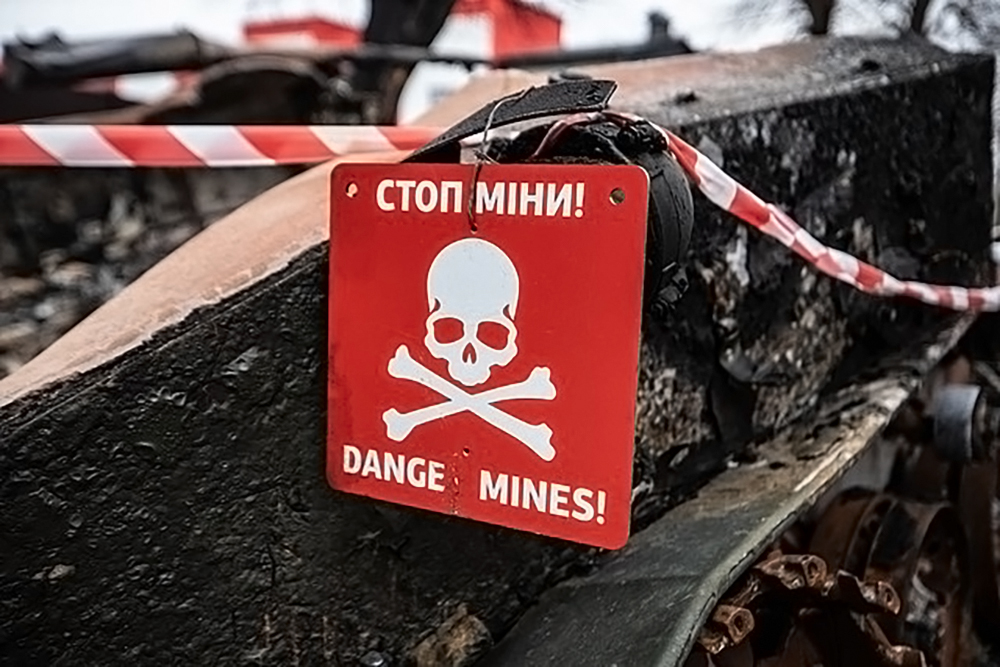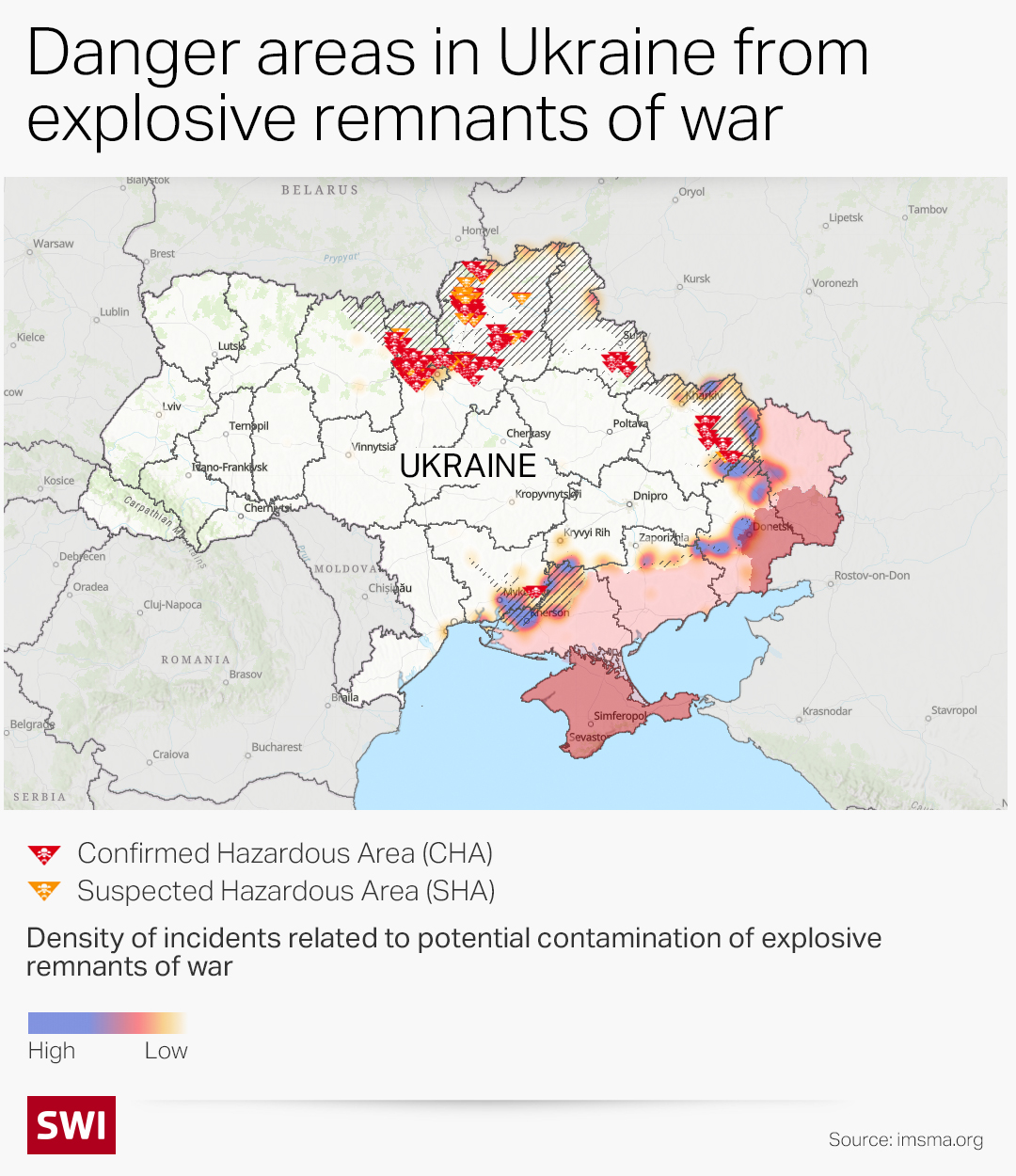
Demining: how the Swiss are helping to make Ukraine safer

Vast swathes of Ukraine are littered with explosives, posing a physical and mental threat to the population. Since February 2022, the situation throughout the country is said to have deterioratedExternal link drastically. To mark International Mine Awareness Day (April 4), we look at how the Swiss are helping to tackle the threat.
How big is the problem?
Anti-personnel and anti-vehicle mines, cluster munitions, as well as other unexploded or abandoned ammunition are littered across cities, farmlands and seaways. It’s estimated that up to 30% of Ukraine has been contaminated.
From February 24, 2022, to February 5, 2023, the Office of the United Nations High Commissioner for Human Rights (OHCHR) recordedExternal link 18,817 civilian casualties in Ukraine, with 7,155 killed and 11,662 injured. This figure includes casualties caused by landmines and unexploded ordnance but also victims of direct artillery shelling and airstrikes. Action on Armed Violence (AOAV) reportedExternal link in 2022 that Ukraine was the country that was most affected by mines and explosive ordnance, followed by Myanmar and Syria.

Ukraine is party to the Ottawa Treaty banExternal link on anti-personnel mines — bombs that are designed to kill and maim individuals who stumble across them.
Human Rights Watch has urged Ukraine’s government to investigate allegations that its military used rocket-fired anti-personnel landmines in and around the eastern city of Izium when RussianExternal link forces occupied the area. Russia is not a party to the 1997 convention and has been documented making wide use of these explosives.
A victim who survives an anti-personnel mine explosion typically requires amputation, multiple operations and prolonged physical rehabilitation.
Both countries have employed anti-vehicle mines. The Mine Ban Treaty does not prohibit these. There’s evidence that landmines are affecting agricultural production in Ukraine. The use of farm vehicles in fields and on rural paths and roads has become a high-risk activity. There is clearly still a long way to go to reach the treaty’s goal of a mine-free world by 2025.
How the Swiss are helping with demining
Global support for eventually rebuilding Ukraine is strong, but no real transformation of the country into a modern European state can take place if it remains littered with mines.
Switzerland provides funding of around CHF16-18 million ($17.3-19.5 million) a year to support international humanitarian demining efforts. That places it among the 15 largest mine action donor countries in the world, according to this government websiteExternal link. On International Mine Awareness Day, the Swiss government unveiled a new action plan for 2023-26 that will expand humanitarian mine action in Ukraine over the next few years. Among other things, the Swiss government is supporting cooperation between those involved in the development of new technologies to increase quality, efficiency, accuracy and safety in the search for mines and other explosive ordnance.
About half of government funds are channelled to the Geneva International Centre for Humanitarian Demining (GICHDExternal link), which was set up by the Swiss in 1998. The GICHD is globally recognised as the leading centre of mine action expertise and knowledge. Within the framework of NATO’s Partnership for Peace (PfP), the Swiss Armed Forces have joined GICHD in helping to train Ukrainian demining experts.
GICHD director, Ambassador Stefano Toscano, says there has generally been good compliance with the mine ban treaty among signatories, but more needs to be done to reduce the danger. “I think the international community must continue to denounce the use of anti-personnel mines, as well as universalising the mine ban treaty,” he said. “It only has 164 state parties, so it’s still not universal.” In this video, Stefano Toscano, elaborates on the paralysing effect of mines on Ukrainian society.
FSDExternal link (Fondation suisse de déminage) is a Swiss NGO whose core function is mine action. Its programme in Ukraine began in 2015, supported by the US State Department, the Swiss foreign ministry and several private foundations. FSD has eight specialised battlefield clearance teams, three mechanical clearance teams, three non-technical survey teams and four risk education teams. The NGO teaches residents how to safely “coexist” with mines and unexploded ordnance, with live lessons in communities, as we see in this video. FSD also runs prevention campaigns on Facebook and its Russian equivalent VKontakte.
Ukraine is home to the largest weapons contamination team of the Swiss-based International Committee of the Red Cross (ICRC)External link. Eighteen ICRC weapons contamination specialists are helping mark and clear areas with unexploded ordnance and are sharing mine safety information with communities and municipal workers.
The ICRC is also helping repair damaged homes and essential infrastructure like water and electricity systems and supporting over one million people with heating.

In compliance with the JTI standards
More: SWI swissinfo.ch certified by the Journalism Trust Initiative


























You can find an overview of ongoing debates with our journalists here . Please join us!
If you want to start a conversation about a topic raised in this article or want to report factual errors, email us at english@swissinfo.ch.